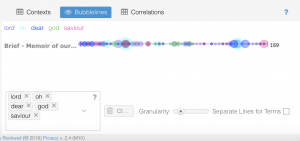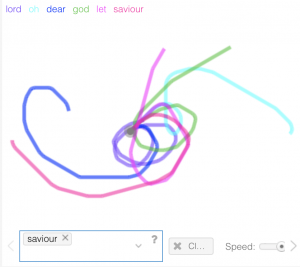My group’s project was to transcribe Esther Latrobe’s memoir. This memoir was a document written in script. After learning to decipher both the handwriting and general writing style of the text, we started to understand the life-story being described to us. Esther Latrobe was born on June 7th, 1802 in Bristol, Germany. She was the only daughter within a family of six children and was “tenderly loved” by both her siblings and parents (page 1). Early on, Latrobe was predisposed to a short life full of hardships. In her childhood, her first challenge was when she caught a deadly case of the measles. Although presently the measles is a relatively easy disease to cure with a high survival rate, such a disease was much more lethal in the 1800s due to a lack of medical resources. This sickness brought her to the brink of death, but with the strength of God, she became well again. A recurring theme within this memoir is her religious faith. She was brought up within a strict Catholic family. From reading this document, the reader can infer that through the many hardships she faced, Latrobe relied on her faith with God to keep moving forward. In fact, her physician always claimed that she had a shockingly high pain tolerance. To prove this claim, she also suffered from a rheumatic fever and heart problems that nearly killed her. However, yet again, she survived. The next devastation she endured was the death of her mother when she was only 11 years old. As the saying goes, nothing cuts deeper than a wounded heart. This wound scarred deeply into her heart, and she often wept in remembrance of her beloved mother. Nonetheless, through the acknowledgment of her friends, she felt the love that drove her to live on with her life. Consistently throughout the memoir, Latrobe looked to God for forgiveness, and then she reflected upon these wrongdoings to become a better person and strengthen her relationship with the Saviour. Even though she had deep emotional ties to the town of Tytherton, in which she spent over 6 years there, she went to Gracehill in 1826 to become a teacher at the “Ladies Boarding School”. Eventually, she went to Ayr and got married to Brother James Latrobe on the 28th of December. Later on, after going through labor for 4 days, she gave birth to a healthy boy on Friday, October 15th. Tragically, after living only 28 years, she died from illness. However, she honorably accepted death and asked her husband and other loved ones not to cry for her because she was now in the hands of the Lord.
After transcribing this document, we inputted our finished text into voyant tools. Within this transcription there are 8496 total words; of these words, 1809 of them are unique word forms. The most frequent terms are synonyms of the word “God” and also the collocates of these synonyms. For example, “Lord” is used 51 times, “Savior” is used 22 times and the word “God” itself is used 26 times. The word “oh” is used 37 times and is collocated with “God” 5 times and collocated with “Saviour” 4 times. The word “dear” is used 33 times and is collocated with “Saviour” 6 times. In the Bethlehem memoir transcribed by another group, they shared the frequent terms “Saviour” and “dear”. By comparing these frequent terms, the viewer can conclude that religion played an important role in the lives of the people from the 1800s.
All this data given to us through voyant tools takes us back to one critical question: What does this data and textual analysis provide to us that standard literature fails to do? “Humans are quite adept at perceptual visual cues and recognizing subtle shape differences. In fact, it has been shown that humans can distinguish shape during the pre-attentive psychophysical process” (Whitley, 193). In his article “Visualizing the Archive”, Edward Whitley explains how the brain is wired to recognize shapes and patterns.

The picture above is a picture of the Cirrus tool from Voyant tools. Just by looking at this representation of the most frequent words, the reader can physically see the religious pattern of the text. Our group’s research question was: “How did Esther Latrobe’s relationship with God affect her lifestyle, and help her recover from such illnesses and hardships?” Without reading Latrobe’s complex and lengthy memoir, our group easily got insight on the importance of religion within her life. Whitley also argues how digital humanities is superior to traditional literature in the sense of how complex text introduces the factor of the bottleneck effect. Although standard reading encourages the reader to pay closer attention, the human brain cannot sustain large intakes of information. When a text becomes too long, visualization tools and graphical analysis is useful.

The visualization above is the tool Bubblelines. This tool spaces out the frequencies of the terms inputted and outputs them as a timeline. In this case, the input was the 5 most common words. Now the viewer would register that not only is religion a recurring topic but this topic is also consistently used throughout the entire memoir. However, as Whitley would agree, the field of Digital Humanities is not perfect. Sometimes, the reader needs the context of the story that only the close reading of literature can provide.

The picture above is the Knots tool. In this tool, you can click on any point of the lines and see the context in which the word was used within the text. However, by no possible means could you understand the in-depth life story of Latrobe from this graphical analysis.
